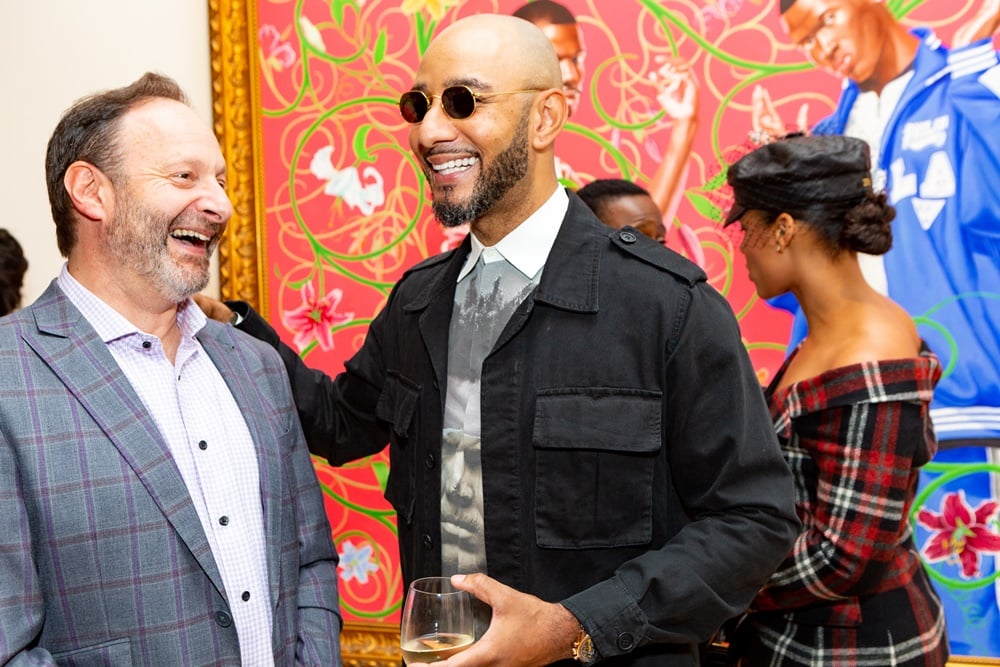
When Sotheby’s tapped Grammy Award-winning hip-hop producer Kasseem Dean, aka Swizz Beatz, to speak to a crowd of roughly 800 art-world denizens ahead of the Contemporary Curated sale he organized, officials knew the event would prove wildly popular. But few could’ve predicted what happened next.
As part of his speech, Dean waded into the ongoing debate about artist resale royalties and secondary-market sales. “I talked about how I think artists should be given a percentage of the sales of their works that are sold at auction,” he told artnet News. “Most of these artists did these works when they were young. When it appreciates, they should be involved in that.”
Dean knows the conversation over artist compensation in the secondary market isn’t new to the art world. (In a now-apocryphal tale, the debate over royalties is said to have begun when the artist Robert Rauschenberg punched collector Robert Scull after he made a hefty profit selling one of his works at auction back in 1973.)
“My reasoning [for] partnering with Sotheby’s is not to sell art that night,” he said. “It’s a way to start a communication with the artists and the auction house and the sellers of the art…to bring everybody together.”
Unbeknownst to Dean, at least one dealer in the audience was thinking the exact same thing. Joel Straus, a former curator at Chicago’s Metropolitan Pier and Exposition Authority and now an art advisor, is the consignor of Kerry James Marshall’s Study for Past Times (1997), which is being offered at today’s Contemporary Curated sale with an estimate of $900,000 to $1.2 million.
Straus bought the study from the artist at the same time he bought the finished work for Chicago’s McCormick Place Art Collection for $25,000. (He declined to state how much he paid for the study.) The painting, Past Times, sold at auction in May to Sean “Diddy” Combs for a record $21.1 million. Now, the study is expected to sell for between $900,000 to $1.2 million—around 3,900 percent more than his client paid for the original painting in 1997.
“It’s always been my belief that artists should be compensated for secondary market sales, just like writers and performing artists,” Straus told artnet News. The dealer adds that he and his wife had been discussing the idea of sharing some of the sale proceeds with Marshall since they made the decision to consign the work.
But there was one catch: Straus never intended to go public with the news. “I was hesitant because this was a very personal decision I had made with my wife,” he said. Following Dean’s speech, he approached the producer to let him know his plans.
Dean encouraged Straus to speak up. “If you’re serious, then tell it to the people because I can’t say it,” Dean said he told the dealer. “I don’t own the work, so coming from the owner…people see this gesture.”
Artist Nina Chanel Abney, who was at Sotheby’s that night, told artnet News that she thinks the idea is a simple one. “If my work resells for a ton of money, it would be great to have some of it,” she said. “All artists talk about it. No one is happy with how it goes. I think it’s a great first step. At the end of the day, it’s just all about supporting the artists. I don’t understand who wouldn’t want to participate in that.”
Straus declined to say how much of the sale proceeds he intends to share with Marshall and has not had a conversation with the artist about it, though he said he has talked to the artist’s longtime dealer, Jack Shainman. (Notably, Shainman encourages collectors to sell works back through the gallery, because he provides his artists with a portion of the resale commission.)
While other countries already enforce visual artist resale rights—and US courts recently struck down a similar provision in California for good—Dean said he’s not out to campaign for a new law. “My motto is different,” he said. “My approach is, ‘Let’s make it a lifestyle, to treat the artists right—especially the artists that are living.'”
Update: Study for Past Times (1997) sold for $1.8 million, including premium, at Sotheby’s Contemporary Curated sale on September 25.